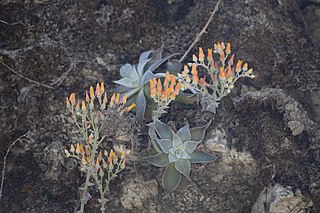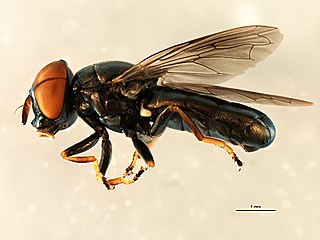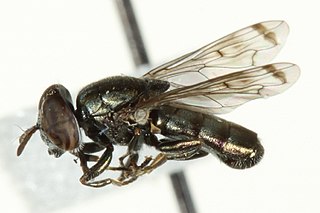
Hyles lineata, also known as the white-lined sphinx, is a moth of the family Sphingidae. They are sometimes known as the hummingbird moth because of their bird-like size and flight patterns.

Philotes is a genus of butterflies in the family Lycaenidae. Philotes is a monotypic genus containing only Philotes sonorensis, the Sonoran blue or stonecrop blue, found in North America in California and Baja California. The habitat consists of rocky washes, outcrops and cliffs in deserts.

Orthonevra is a genus of fly in the syrphidae family with at least 59 species identified so far. They are worldwide in distribution but concentrated in the Eastern North America and Europe.Orthonevra are commonly called Mucksuckers after the larvae which have been found in organic rich mud, i.e. muck. This genus belongs to the tribe Brachyopini that includes the prominent genera Melanogaster, Brachyopa, Neoascia and Sphegina. Orthonevra have black heads with blue to purple reflections. Many species have distinctive eye stripes. The antennae are somewhat elongate. The frons is wrinkled with silvery spots at sides of antennae. The thorax with small punctures dorsally and in several species the body is covered with scale-like pile. Wingd vein M1 curves away from the wing tip.(see images)

The Brachyopini is a tribe of hoverflies. Unlike many members of this family these flies are generally darker and less colourful though some genera contain species with an attractive metallic lustre e.g. Chrysogaster. Some like Brachyopa are associated with sap runs where their larvae feed on decaying sap. Others are found in boggy areas where their often semiaquatic larvae feed on decaying organic matter.
Prodoxus sonorensis is a moth of the family Prodoxidae. It is found in south-eastern Arizona, United States, and south into northern Sonora, Mexico.
Flaveria sonorensis is a rare Mexican plant species of Flaveria within the family Asteraceae. It has been found only in southern Sonora and southwestern Chihuahua in northwestern Mexico. Some of the populations lie very close to hot mineral springs.
Orthonevra flukei (Sedman, 1966), Fluke's Mucksucker, is an uncommon species of syrphid fly It has been observed in the Western United States. Hoverflies get their names from the ability to remain nearly motionless while in flight. The adults are also known as flower flies for they are commonly found around and on flowers from which they get both energy-giving nectar and protein-rich pollen. Larvae for this genus are of the rat-tailed type. O. flukei larvae have been described.

Orthonevra pictipennis (Loew,1863), the Dusky-veined Mucksucker, is an uncommon species of syrphid fly. It has been observed in North America. O. pictipennis shares much of the same range as O. pulchella, O. nitida and O. feei. Hoverflies get their names from the ability to remain nearly motionless while in flight. The adults are also known as flower flies, for they are commonly found around and on flowers from which they get both energy-giving nectar and protein-rich pollen. Larvae for this genus are of the rat-tailed type. O. pictipennis larvae have not been described.

Orthonevra nitida , the wavy mucksucker, is a fairly common species of syrphid fly. It has been observed in Eastern and Central North America. Hoverflies get their names from the ability to remain nearly motionless while in flight. The adults are also known as flower flies for they are commonly found around and on flowers from which they get both energy-giving nectar and protein rich pollen. Larvae for this genus are of the rat-tailed type. O. nitida larvae have not been described.
Orthonevra bellula , the Three-lined Mucksucker, is a rare species of syrphid fly found in the Southern California Hoverflies get their names from the ability to remain nearly motionless while in flight The adults are also known as flower flies for they are commonly found around and on flowers from which they get both energy-giving nectar and protein-rich pollen. Larvae for this genus are of the rat-tailed type. O. bellula larvae have not been described.

Orthonevra pulchella (Williston 1887) the Dusky Mucksucker is a fairly common species of syrphid fly. It has been observed from across northern North America. Hoverflies get their names from the ability to remain nearly motionless while in flight. The adults are also known as flower flies for they are commonly found around and on flowers, from which they get both energy-giving nectar and protein-rich pollen. Larvae for this genus are of the rat-tailed type. O. pulchella larvae have not been described.

Dudleya cymosasubsp. pumila, most commonly known as the low canyon dudleya, chalky canyon dudleya or California live-forever, is a species of perennial succulent plant. It has diamond to spoon shaped leaves, sometimes coated with a fine white powder, and in May through July, bright red, orange or yellow flowers adorn the short inflorescence. A leaf succulent primarily found growing in rocky cliffs and slopes, it is endemic to California, and grows in the Transverse Ranges and South Coast Ranges, with some outlying populations. A variable plant, in some localities it is difficult to distinguish from other plants in the genus.

Orthonevra anniae (Sedman, 1966), the shiny-sided mucksucker, is a rare species of syrphid fly. It has been observed in Northeastern North America. Hoverflies get their names from the ability to remain nearly motionless while in flight. The adults are also known as flower flies for they are commonly found around and on flowers, from which they get both energy-giving nectar and protein-rich pollen. Larvae for this genus are of the short tailed rat-tailed type. O. anniae larvae have not been described.

Orthonevra feei, Fee's mucksucker, is a rare species of syrphid fly. It has been observed only in New Hampshire, United States. Hoverflies get their names from the ability to remain nearly motionless while in flight. The adults are also known as flower flies, for they are commonly found around and on flowers from which they get both energy-giving nectar and protein-rich pollen. Larvae for this genus are of the rat-tailed type. O. feei larvae have not been described.
Orthonevra parva , the copper-striped mucksucker, is a rare species of syrphid fly. It has been observed in the Western United States. Hoverflies get their names from the ability to remain nearly motionless while in flight. The adults are also known as flower flies, for they are commonly found around and on flowers from which they get both energy-giving nectar and protein rich pollen. Larvae for this genus are of the rat-tailed type. O. parva larvae have not been described.
Orthonevra stigmata, the black-headed mucksucker, is a rare species of syrphid fly. It has been observed in Southern California. Hoverflies get their names from the ability to remain nearly motionless while in flight The adults are also known as flower flies, for they are commonly found around and on flowers from which they get both energy-giving nectar and protein-rich pollen. Larvae for this genus are of the rat-tailed type. O. stigmata larvae have not been described.
Orthonevra weemsi, the Weems' mucksucker, is a rare species of syrphid fly. It has been observed in eastern North America. Hoverflies get their names from the ability to remain nearly motionless while in flight. The adults are also known as flower flies for they are commonly found around and on flowers, from which they get both energy-giving nectar and protein-rich pollen. Larvae for this genus are of the rat-tailed type. O. weemsi larvae have not been described.

Orthonevra nigrovittata (Loew, 1876), the black-lined mucksucker, is a rare species of syrphid fly. It has been observed in California. Hoverflies get their names from the ability to remain nearly motionless while in flight. The adults are also known as flower flies for they are commonly found around and on flowers from which they get both energy-giving nectar and protein rich pollen. Larvae for this genus are of the rat-tailed type. O. nigrovittata larvae have not been described.
Total of 245 species either found or highly expected to be found in New York.
Orthonevra robusta, the short-horned mucksucker, is a rare species of syrphid fly, located in the Western United States. It was described by Raymond Corbett Shannon in 1916. Hoverflies are able to be motionless while in flight.They are also called flower flies, for they are commonly found around and on flowers from which they get both energy-giving nectar and protein rich pollen. Larvae for this genus are of the rat-tailed type. O. robusta larvae have not been described.










